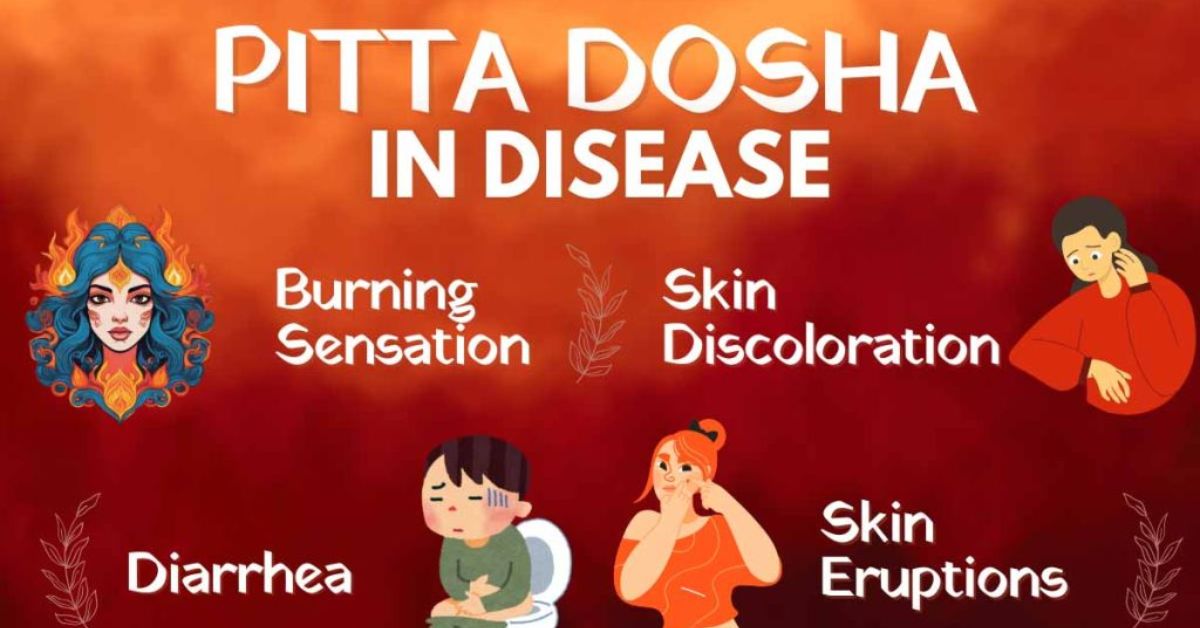In Ayurveda, Pitta Dosha is one of the three primary energies or “Doshas” that govern our physical and mental well-being. Associated with the elements of fire and water, Pitta is responsible for digestion, metabolism, and transformation in the body. When balanced, Pitta provides clarity, intelligence, and vitality. However, an imbalance can lead to a range of issues, such as irritability, inflammation, and digestive problems.
Understanding Pitta Dosha: Key Traits, Symptoms, and Balancing Tips is essential for maintaining harmony in your body and mind.
This article explores the defining characteristics of pitta symptoms, common signs of imbalance, and effective tips to restore balance. By making mindful lifestyle adjustments, incorporating cooling foods, and practicing calming activities, you can keep Pitta in check and enjoy improved overall health. Whether you’re looking to prevent or manage a Pitta imbalance, these insights offer practical guidance for achieving equilibrium in your daily life.
Key Traits of Pitta Dosha
Physical Characteristics
People with a dominant Pitta Dosha often exhibit distinct physical traits that reflect the fiery nature of this Dosha. Typically, individuals with a strong Pitta constitution have a medium build, balanced between the lean structure of Vata and the heavier build of Kapha. Their body temperature tends to run warm, and they may sweat more easily, especially in hot climates. Pitta types often have sharp features, such as a pointed nose or well-defined jawline. Another common trait is their strong digestive fire, or Agni, which enables them to digest food efficiently. However, this also means they can become irritable or uncomfortable when they miss meals. Additionally, Pitta individuals frequently have a reddish or rosy complexion and may be prone to skin sensitivities, such as rashes, inflammation, or acne, especially when their Pitta is aggravated.
Mental Characteristics
Mentally, Pitta Dosha is linked to intelligence, focus, and decisiveness. Pitta-dominant individuals tend to have sharp, analytical minds and are natural leaders who excel in tasks requiring concentration and organization. Their ability to make quick decisions, stay goal-oriented, and tackle challenges head-on often puts them in leadership roles. However, the intensity that fuels their mental sharpness can also make them prone to irritability, impatience, or even anger when their Pitta is imbalanced. These individuals are typically ambitious and driven, but they must not let their fiery temperament lead to burnout or conflict. When balanced, Pitta types are brilliant, dynamic, and inspiring, but their sharpness can manifest as aggression or frustration when out of balance.
Symptoms of Pitta Dosha Imbalance

Common Physical Symptoms
When pitta symptoms becomes imbalanced, it can manifest through a variety of physical symptoms, often linked to excess heat in the body. One of the most common signs is digestive discomfort, including acid reflux, heartburn, or indigestion, as the fiery nature of Pitta aggravates the stomach. Skin-related issues are also frequent, with conditions such as rashes, acne, redness, and inflammation becoming more prominent. Those experiencing a Pitta imbalance may notice increased sensitivity to heat and excessive sweating, particularly in hot weather or after consuming spicy foods. Additionally, joint or muscle inflammation can arise, leading to discomfort or pain.
Mental/Emotional Symptoms
An imbalance in pitta dosha symptoms affects the body and significantly impacts emotional well-being. Mentally, those with excessive Pitta may become easily irritated, often experiencing feelings of frustration or impatience. Outbursts of anger, mood swings, and a tendency toward being overly critical are common emotional symptoms. Since Pitta is closely tied to drive and ambition, an imbalance can push individuals to become overly competitive, stressed, or perfectionistic, affecting their mental clarity and peace of mind.
Signs of Excess Pitta
Excess Pitta manifests clearly in the body as internally and externally overheating. Physically, this can result in burning sensations, especially in the stomach or chest, due to excessive acid production. Redness in the skin, eyes, or face is also a common sign, often accompanied by hot flashes or a persistent feeling of warmth. Conditions that cause inflammation, such arthritis or skin inflammation, may flare up when Pitta is aggravated. Additionally, excessive Pitta may cause a person to feel constantly hungry or thirsty but also prone to irritability if they do not eat or drink regularly.
By balancing your pitham symptoms, early detection and treatment of these symptoms can help you regain mental and physical equilibrium.
Causes of Pitta Imbalance
Dietary Causes
One of the primary causes of pitta symptoms imbalance is related to diet. Pitta, being governed by the elements of fire and water, can be easily aggravated by consuming foods that enhance heat in the body. Spicy, sour, and salty foods are particularly aggravating for Pitta. For example, dishes made with hot spices like chili peppers, sour fruits like lemons, and salty snacks can increase internal heat, causing digestive issues like acid reflux or heartburn. Additionally, consuming excessive oily or fried foods may lead to inflammation, further disturbing Pitta. To maintain balance, it is essential to favor cooling, bitter, and sweet foods that help pacify this Dosha, such as leafy greens, cucumbers, and sweet fruits.
Lifestyle Causes
Lifestyle decisions can sometimes make a big difference on home remedies for pitta vomiting. High levels of stress, overworking, and pushing oneself to the limit are common factors that increase Pitta. People with a Pitta constitution tend to be driven and ambitious, which can lead to burnout and irritability if not managed properly. Excessive heat from environmental factors, like hot weather or spending too much time in the sun, can also exacerbate Pitta, resulting in overheating or inflammation. Additionally, not getting enough rest or relaxation, particularly in stressful periods, contributes to Pitta imbalance, leaving individuals feeling mentally strained and emotionally reactive. Can you use CBD for Bodybuilding?
Seasonal Influence
Pitta is most active during the summer and early autumn when the heat in the environment is naturally higher. During these warmer months, the body is more susceptible to Pitta imbalances, especially if appropriate measures are not taken. Prolonged exposure to the sun, indulging in spicy summer barbecues, or staying in overheated environments can all increase internal heat, leading to symptoms like skin rashes, dehydration, and excessive sweating. To counteract this seasonal influence, it is important to adopt cooling practices, stay hydrated, and avoid overheating through diet and lifestyle adjustments during the Pitta-dominant times of the year.
By being mindful of these dietary, lifestyle, and seasonal factors, it is possible to prevent and manage Pitta imbalances before they lead to more serious health concerns.
Balancing Pitta Dosha: Effective Tips

Dietary Recommendations
To balance Pitta Dosha, it is essential to focus on cooling, sweet, and bitter foods that help alleviate the fiery nature of Pitta. Fresh, hydrating fruits like cucumbers, melons, apples, and Leafy greens are a great option, such as kale and spinach. Dairy products like milk and ghee also have a cooling effect and can help soothe an aggravated Pitta. It’s important to avoid foods that increase heat in the body, such as spicy dishes, fried foods, and acidic ingredients like vinegar or citrus fruits. Reducing the intake of caffeine, alcohol, and overly salty foods can further help maintain Pitta balance. Instead, favor mild flavor dishes, well-cooked, and lightly spiced to nourish and cool the body.
Lifestyle Adjustments
Balancing Pitta Dosha extends beyond diet and requires lifestyle changes that promote calm and relaxation. Pitta types tend to be high-energy and ambitious, but engaging in calming activities is important to prevent burnout. Gentle yoga, meditation, and breathing exercises (Pranayama) can be particularly effective in grounding Pitta’s intense energy. Spending time in cool environments, avoiding excessive exposure to the sun, and incorporating breaks during the workday can help regulate Pitta’s heat. Prioritizing work-life balance is crucial for avoiding mental and emotional overheating, as Pitta-dominant individuals are prone to stress and impatience when overworked reason for pitta.
Herbs and Remedies
Certain Ayurvedic herbs are especially beneficial for calming Pitta. Aloe Vera, Neem, and Brahmi are known for their cooling and anti-inflammatory properties, helping to reduce excess heat in the body. Juice from aloe vera plants helps calm the digestive tract while Neem helps with skin conditions like rashes or acne. Brahmi is a wonderful herb for calming the mind and promoting mental clarity. Additionally, incorporating oil massages (Abhyanga) using cooling oils like coconut oil or sunflower oil can help pacify Pitta. These oils cool the skin, reduce inflammation, and provide a soothing experience that helps calm both body and mind.
Daily Routine
Establishing a daily routine (Dinacharya) that aligns with Pitta’s needs is crucial for maintaining balance. Waking up early, ideally before sunrise, allows for a peaceful start to the day. Drinking plenty of water and herbal teas will help you stay hydrated throughout the day, which is vital for keeping Pitta cool. Regular mindfulness practices like meditation or journaling can create a sense of inner calm and reduce Pitta’s tendency toward irritability. Maintaining a consistent meal schedule is also important, as skipping meals can lead to an aggravated Pitta. By following a structured daily routine emphasizing cooling and calming practices, Pitta types can remain balanced and healthy.
With these dietary changes, lifestyle adjustments, herbal remedies, and daily routines, you can effectively balance Pitta Dosha and enjoy greater physical, mental, and emotional well-being CBD And Autism.
Conclusion
Maintaining balance in Pitta Dosha is essential for long-term health and overall well-being. Understanding Pitta’s key traits, recognizing symptoms of imbalance, and making mindful adjustments in diet, lifestyle, and daily routine can significantly improve physical and emotional health. By focusing on cooling foods, engaging in calming activities, and incorporating Ayurvedic herbs, individuals can prevent Pitta from becoming aggravated and causing discomfort or illness. Balanced Pitta brings clarity, vitality, and focus, while an imbalance can lead to irritability, inflammation, and overheating.
Staying aware of the signs of Pitta imbalance and adopting simple, mindful practices can make a big difference in maintaining harmony. Whether through cooling dietary choices, stress management, or regular self-care routines, these small steps can help keep excess pitta symptoms in check. By nurturing this balance, you promote a healthy and vibrant mental and physical life.
FAQs:
What is Pitta Dosha?
In Ayurveda, the Pitta Dosha is one of the three basic energies. It is responsible for transformation and metabolism in the body and governs digestion, absorption, body temperature, and intelligence. Pitta has a fiery, sharp, and intense quality because it is mainly made up of fire and water elements.
What are the key traits of Pitta Dosha?
Key traits of Pitta Dosha include:
- A medium, muscular build
- Sharp intellect and focus
- Strong appetite and digestion
- Warm body temperature
- Competitive, driven, and ambitious personality
- Prone to irritability or impatience under stress
What are the common symptoms of a Pitta imbalance?
When Pitta is out of balance, it can manifest in several ways, such as:
- Acid reflux, heartburn, or indigestion
- Skin rashes, inflammation, or acne
- Excessive sweating or body heat
- Irritability, anger, or impatience
- Frequent headaches or migraines
- Feeling overly critical or frustrated
What are some common causes of Pitta imbalance?
Pitta imbalance can be triggered by various factors, including:
- Overconsumption of spicy, sour, or fried foods
- Excessive heat, either from weather or the environment
- Skipping meals or irregular eating habits
- Stress, competition, or high-pressure environments
- Overworking or pushing yourself too hard




